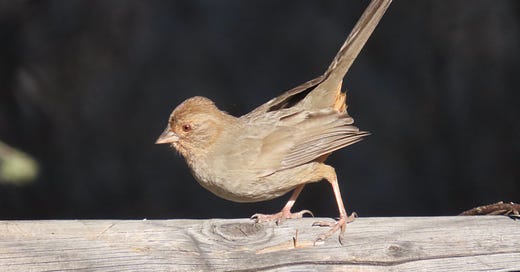Somebody keeps messing up my yard. It seems intentional. I’ll sweep the loose mulch and wood chips off my walkways and steppingstones but then a day later the debris is sprayed all over the very same places I swept the day before. What gives?
I have great neighbors, we talk and occasionally share stories about our kids, sports, neighborhood gossip, or even politics when I get the urge to debate; but I know who is responsible for the mess in my yard. I caught them in the act. It’s one of my other non-human neighbors that flies, walks, or hops around our co-joining lots. We have many creatures we share our land with, and I feel it is only polite and respectful to get to know and understand them. After all, many of their families have lived in our neighborhood longer than we have! So, with that in mind let’s get to know one of our neighbors.
Our neighbor that I caught messing up my walkways and stepping stones, is one that I’m sure almost everyone reading this has seen or heard. It is a plain chunky, dull brown ground bird with a longish tail. Aside from its rusty reddish crissum (the area hidden under its tail by its vent, aka cloaca), the California Towhee is unremarkable to look at but at the same time remarkable in other ways. Unlike some of the colorful warblers or orioles that are seasonal visitors, only coming during the winter or summer our towhees are with us all year round. Not only that, but they also have a strong pair bond; together the birds will stay with their mates in their territory around our house for years and years.
Because California Towhees stay together and don’t migrate, there’s really no need for a male to sing much as he already has his mate and territory. What song they do occasionally sing is merely a few well-spaced metallic chips that rapidly accelerate into a trill and then stop abruptly. The whole thing lasts all of 1 to 2 seconds. Instead, it’s more common to hear the towhee pairs “sing” duets, a rapid series of squeals and squeaks, that reinforces their pair bond and lets their neighbors know there is an active pair in this territory and willing to defend the resources in it to raise their brood.
The other call that many may recognize from this hopping brown bird is their contact call, a clear metallic chip that can sometimes intensely pierce the morning air. It’s basically, a call to their mate saying, “Hey, you there?” If their mate doesn’t answer, the first bird will sometimes repeat the call a little more urgently until they get a response.
If we pay attention, we will see these low-key, sedentary birds around our homes and bird feeders, and in the spring, we’ll see evidence of their forays to find food for their young around our yards and neighborhoods. Towhees are primarily seed or berry-eating birds but will also eat insects. Like all birds, their young need the protein and other essential nutrients that only insects can provide. Spiders are particularly important in young bird diets for the amino acid taurine that can be found in their bodies and is essential for brain development.
Sometimes you’ll see these birds searching nooks and crannies around our houses or fences for these tasty tidbits to feed their young. More often the towhees use what Sibley calls a double-scratch maneuver, jumping up and down with both feet raking their feet backward, and sending leaves and other debris behind them. After several of these maneuvers, they’ll come to rest in a standing position and examine the ground around their feet to see if any critters have been uncovered. It’s a pretty effective way to find food. I just wish we could teach them to clean up afterward, so I don’t have to keep sweeping all the debris off my walkways!




